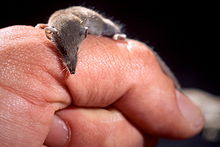Small mammal

Small mammals or micromammals are a subdivision of
A significant majority of mammal species falls into the category of small mammals.[1][2] They are found in a great range of habitats and climate zones.[3]
Characteristics
Many small mammals have a short livespan and high fertility rate, resulting in a comparatively high variability in genetic composition. Their size leads to a reduced energy need for movement, but a high energy requirement for maintaining body temperature. This results in a high rate of food intake, using a wide range food sources. Their small size, together with frequently nocturnal or
Research and conservation
The SSC Small Mammal Specialist Group (SMSG) of the IUCN "serves as the global authority on the world's small mammals" both with regard to research as well as conservation efforts.[5]
References
- ^ ISBN 978-4-431-36024-7.
- ^ S2CID 30468834.
- ^ ISBN 978-0-8018-7950-0.
- ^ "Small Mammals". Small Mammal Specialist Group (SMSG). Retrieved April 13, 2022.
- IUCN. 8 January 2019. Retrieved April 13, 2022.
